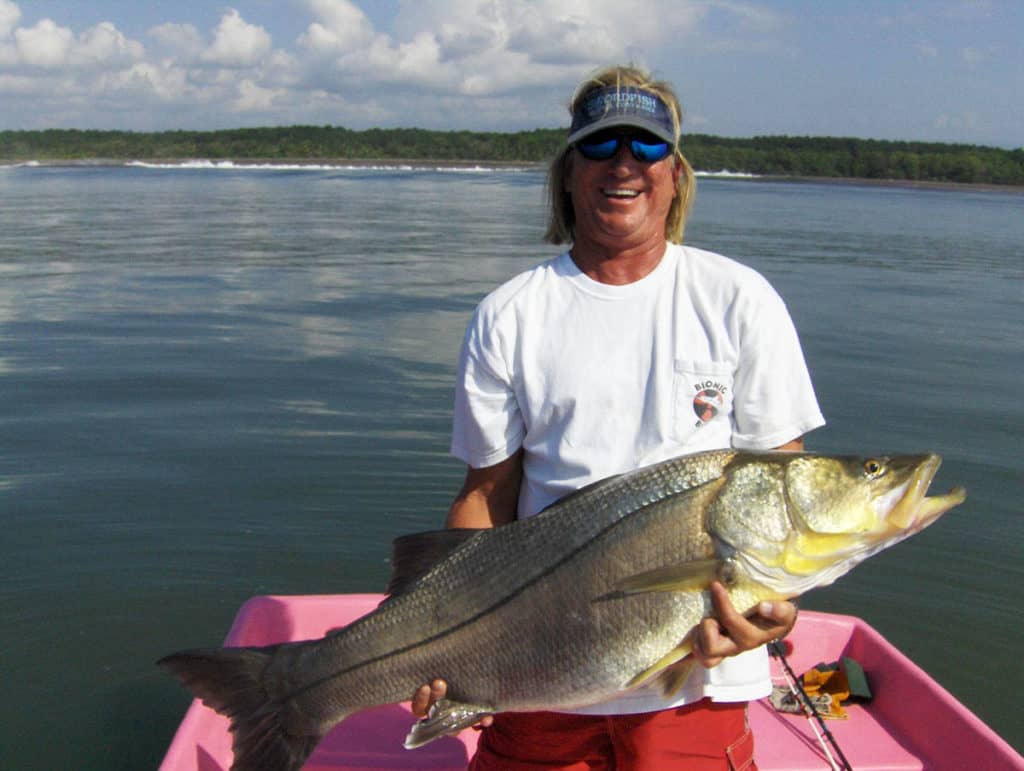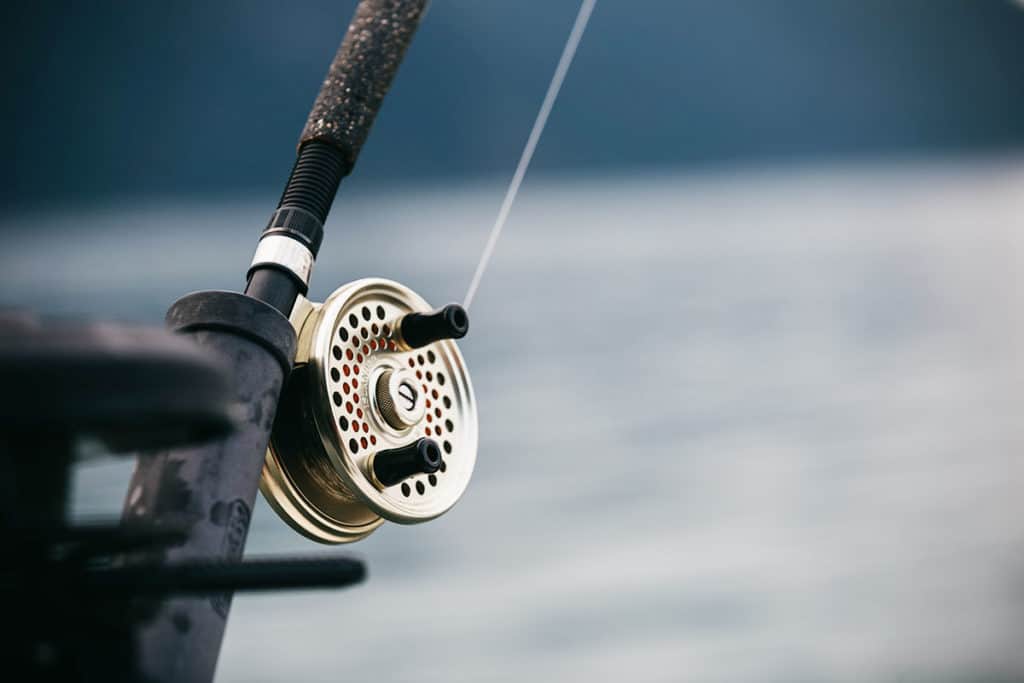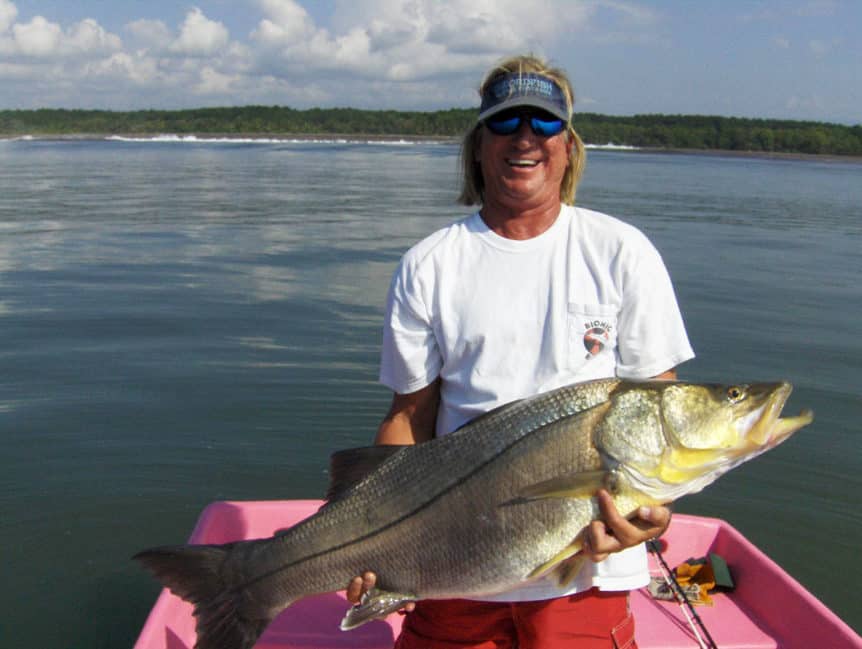
Fishing for snook in Costa Rica is a popular activity among anglers, as the country has a diverse range of snook species and is home to great fishing spots. The most common species of snook found in Costa Rica are the Common Snook, Fat Snook, Swordspine Snook, and Tarpon Snook.
The best time to fish for snook in Costa Rica is during the rainy season, from May to November, when the water is warmer and the fish are more active. They can be found in coastal waters, estuaries, and rivers, and can be caught using various methods such as casting with artificial lures or natural baits, or fly fishing.
The 4 Snook Species in Costa Rica
1. Common Snook
The Common Snook, also known as Centropomus undecimalis, is a species of fish found in the coastal waters, estuaries, and rivers of Costa Rica and is known for its strong fighting ability. Common Snook can grow to a large size and can weigh up to 30 pounds.
The best time to fish for Common Snook in Costa Rica is during the rainy season, from May to November, when the water is warmer and the fish are more active. They can be caught using various methods such as casting with artificial lures or natural baits, or fly fishing. They are known to be aggressive feeders and can be caught during both day and night.
When fishing for Common Snook, it’s important to use the appropriate tackle, such as heavy spinning or conventional gear with a minimum of 40 lb. test line.
2. Fat Snook
These feisty critters begin showing up in November and are taken through February. In December and January they are in schools of thousands. They are similar in appearance to the common snook, but have a more robust body and a larger mouth. They are considered a game fish and are popular among anglers.
Fat Snook can be caught using various methods, such as casting with artificial lures, such as soft plastic worms or jigs, or natural baits like shrimp or mullet. They can also be caught by fly fishing using flies that imitate small baitfish. They are known to be opportunistic feeders and can be caught during both day and night.
It is no great feat to catch 50 of them in a day. There is a difference of opinion where they come from. Some think they are leaving Lake Nicaragua on the way to the ocean to spawn. Others believe they are a reef snook and enter the river to travel up current the great lake.
One thing is certain: They are only found in bodies of water that eventually lead to Lake Nicaragua. Fat Snook are taken by jigging, trolling and casting crankbaits.
In years past, anglers used to come down in droves, filling their coolers with fillets before returning home. Today that attitude has changed somewhat and a few are taken back to camp for dinner while most are released.
The locals call fat Snook “calva” or “calba” and like their origin, there is even a difference of opinion on how to spell their name.
3. Tarpon Snook

The Tarpon Snook, also known as the False Snook or Menticirrhus undulatus, is a species of fish found in the Caribbean waters of Costa Rica. They resemble the tarpon with their huge eye and anal fin but is not a true snook, but it is related to it and is known for its distinctive body shape and large mouth. They can be found in estuaries, mangrove swamps and near the mouths of rivers.
Tarpon Snook are considered a game fish and can be caught using various methods. One popular method is casting with artificial lures, such as soft plastic worms or jigs, or natural baits like shrimp or mullet. They can also be caught by fly fishing using flies that imitate small baitfish.
.A smaller Snook, usually 2 to 3 lbs., they make for great fun on ultralight tackle, easily caught within fresh hatches of shrimps because they often clear the water completely in their excitement to fill their bellies.
Small bucktail jigs or flies will fool them and they also make for great table fare. The locals refer to them as “cara seca” which means dry face.
4. Swordspine Snook
It is a large species of snook, and can be easily recognized by the sharp spine on its dorsal fin. They are considered a game fish and are popular among anglers.
Swordspine Snook can be caught using various methods, such as casting with artificial lures, such as soft plastic worms or jigs, or natural baits like shrimp or mullet. They can also be caught by fly fishing using flies that imitate small baitfish. They are known to be aggressive feeders and can be caught during both day and night.
When fishing for Swordspine Snook, it’s important to use the appropriate tackle, such as heavy spinning or conventional gear with a minimum of 40 lb. test line.
They are usually caught by accident while fishing for other backwater exotics like guapote, mojarra and machaca. Small top water plugs, jigs, and flies will aggravate them into striking. The locals call them by an English name, “hard bone”.
Final Thoughts
Fishing for snook in Costa Rica is a popular activity among anglers, as the country has a diverse range of snook species, and it’s a great spot for fishing. It’s important to be aware of the local regulations, to practice catch and release, and to be mindful of the environment. And also, to use the appropriate tackle, and to be aware of the best time to fish for snook in Costa Rica.

